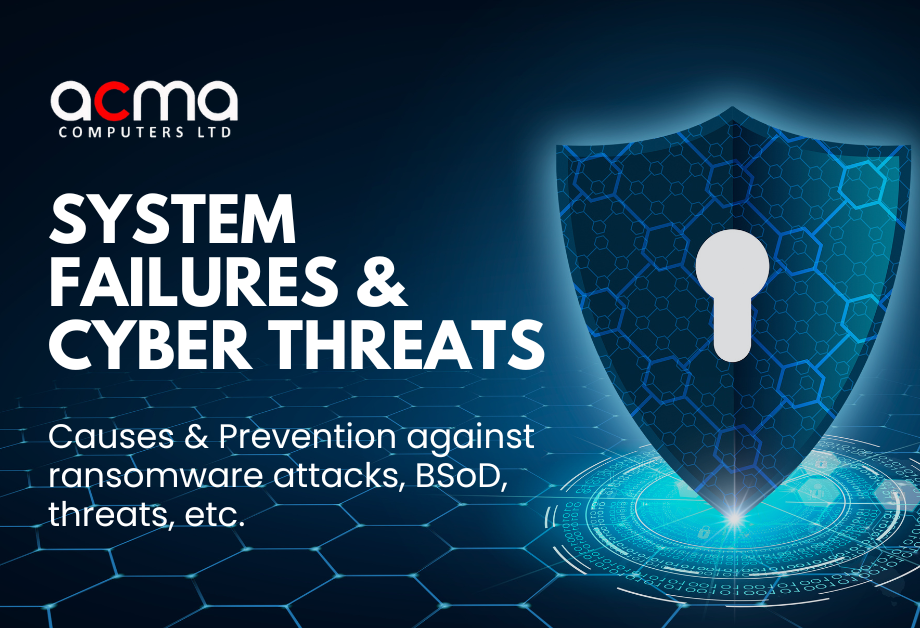From the notorious Blue Screen of Death (BSOD), which signals critical system failure in Microsoft Windows, to the alarming rise in ransomware attacks, phishing scams, and DDoS assaults, these threats are becoming increasingly sophisticated and damaging.
As these cyber threats continue to grow in frequency and complexity, it’s essential for organizations to adopt proactive measures to safeguard their systems and ensure business continuity.
Causes of Threats
1. Hardware Failures: Degradation or malfunction of critical components such as RAM, hard drives, and power supplies can precipitate threats. Thermal failure due to inadequate cooling or faulty hardware often results in operational instability.
2. Driver Issues: Corruption, obsolescence, or incompatibility of device drivers are frequent causes of threats, as they disrupt this critical communication.
3. Software Conflicts: Incompatibility or corruption of system files by third-party software, particularly those with deep system integration.
4. Overclocking: Excessive overclocking of CPU or GPU components, beyond their manufacturer-specified limits, can induce thermal and operational instability.
5. Virus and Malware: Malicious software poses a significant threat by corrupting system files and drivers.
6. Corrupted Registry: The Windows registry, a hierarchical database crucial for system configuration, can become corrupted, leading to severe system failures.
Preventive Measures
A multifaceted approach is essential to prevent such threats, which entails proactive hardware maintenance, diligent software management, and consistent system updates. Critical preventive measures encompass:
1. Regular Driver Updates: Maintain up-to-date hardware drivers from certified sources to ensure compatibility with the latest Windows patches and updates, to minimize the risk of installing corrupted or malicious drivers.
2. Hardware Health Monitoring: Conduct regular inspections and maintenance of hardware components. Sustain system integrity by implementing appropriate cooling measures and promptly replacing any malfunctioning hardware.
3. Software Vetting and Management: Only install software from trusted sources and verify compatibility with your Windows version. Conduct thorough testing of new software in controlled environments before deployment to production systems.
4. Comprehensive Malware Protection: Deploy advanced antivirus solutions to perform regular system scans and eliminate viruses and malware. Regularly update antivirus software to protect against emerging threats.
5. Prudent Overclocking Practices: Limit overclocking to manufacturer-recommended levels to maintain system stability. Employ robust monitoring tools to track system performance and thermal levels during overclocking activities.
6. Routine System Updates: Regularly apply Windows updates to benefit from security patches and performance enhancements.
7. Data Backup Strategies: Implement regular and reliable data backup protocols to safeguard critical information against potential data loss due to system crashes. Use both on-site and off-site backup solutions for comprehensive data protection.
8. System File Integrity Checks: Utilize built-in Windows tools such as System File Checker (SFC) and Deployment Imaging Service and Management Tool (DISM) to detect and repair corrupted system files, ensuring system integrity.
9. Startup Program Management: Optimize startup processes by limiting the number of applications that launch at startup. Utilize tools such as Task Manager or dedicated startup management utilities to control and streamline startup operations, reducing system load and potential conflicts.
Conclusion
These threats signifies critical underlying system issues that demand immediate attention. A comprehensive understanding of its causes, coupled with proactive and technical preventive measures, can significantly mitigate its occurrence. By prioritizing regular maintenance, diligent software management, and consistent system updates, IT professionals can ensure a stable and reliable computing environment, minimizing the risk of attacks and optimize system performance.

